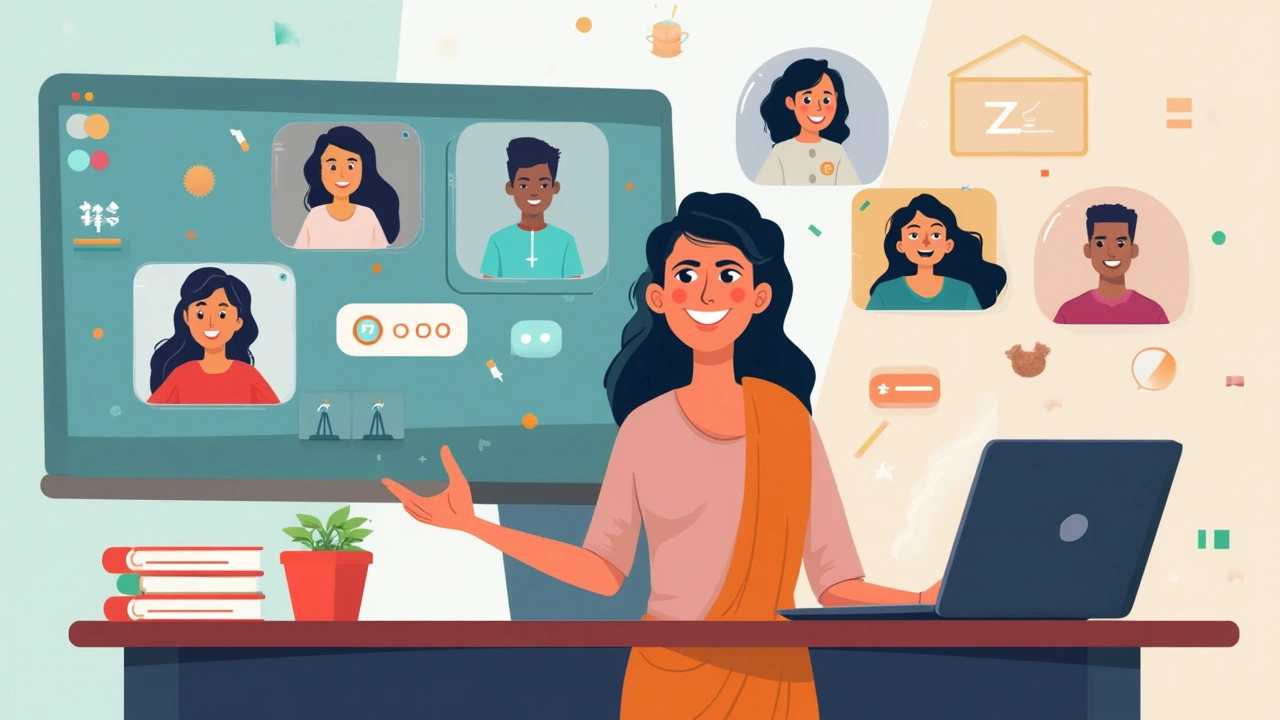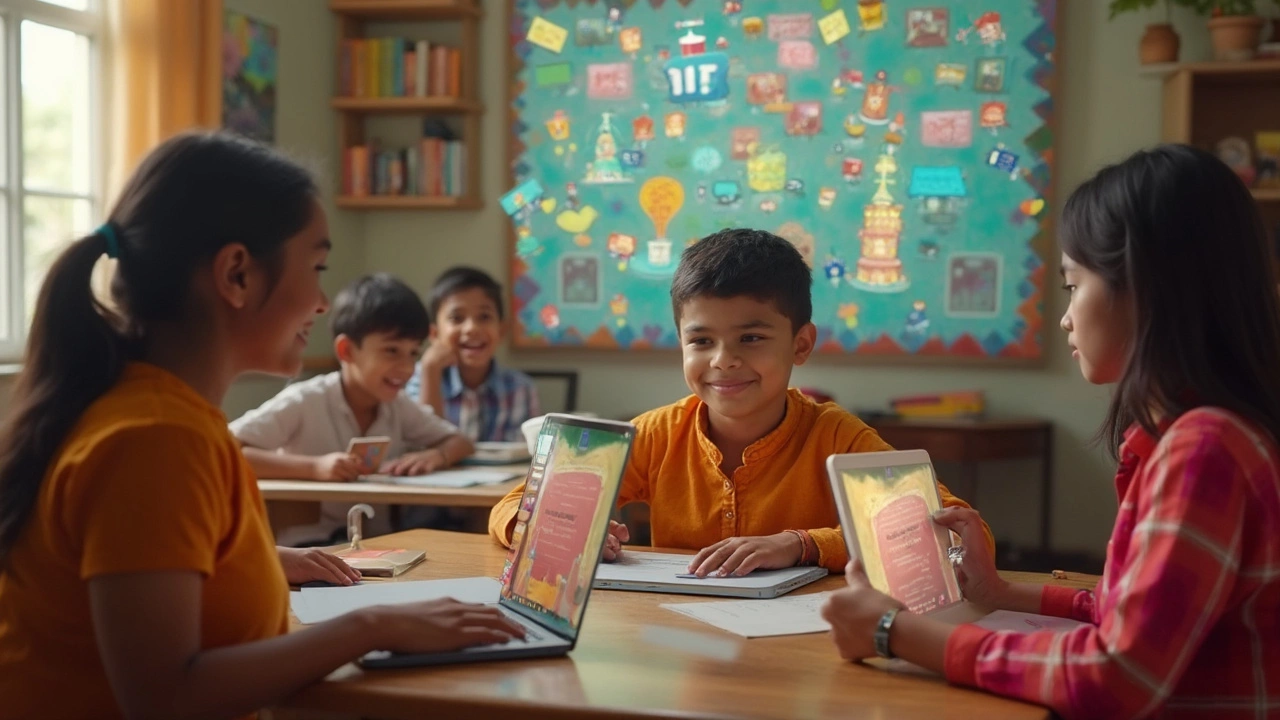Picture a classroom, but it’s not in a school building. It’s wherever your laptop, tablet, or even your phone is. That’s the whole idea behind an e-platform: it’s a digital place where learning happens. No dress code. No standing in line for lunch. Just you, an internet connection, and access to lessons, quizzes, and other people learning right alongside you—even if they live halfway across the world.
If you’ve ever used Google Classroom, Udemy, or Coursera, you’ve already seen an e-learning platform in action. They bring together videos, assignments, forums, and live classes that you can join from home or on the go. You don’t have to be a tech whiz to get the hang of them either. Most platforms are made to be pretty user-friendly and look sort of like the social media apps you’re already used to.
What’s wild is just how much these platforms have grown. A few years ago, only colleges and big companies used them. Now, even school kids hop onto Zoom or Teams to attend classes. Reports say that by 2025—yep, we’re living it—the e-learning market is worth well over $400 billion globally. That’s a crazy leap from where things started, and it proves people really want to learn online.
- E-Platform: What’s the Deal?
- Why E-Learning Platforms Matter
- Key Features That Make Life Easier
- Common Pitfalls and How to Dodge Them
- Getting the Most from Your E-Platform
E-Platform: What’s the Deal?
If you’re still not sure what an e-platform is, think about your favorite streaming service, but swap out TV shows for actual learning stuff—courses, homework, class discussions. That’s your e-platform. Instead of bumping elbows in a classroom, students and teachers meet up in a shared online space.
A true e-learning platform is way more than just a site with some reading materials. It’s loaded with features to make learning easier, faster, and honestly, more convenient. You’ve got:
- Recorded video lectures you can watch any time (no more missing class if your dog eats your homework).
- Interactive forums where you ask questions and swap ideas, day or night.
- Immediate quizzes that show you what you really know.
- Assignment uploads—no more printing or frantic email chains.
- Live sessions for real-time classes, breakout rooms, and even group projects.
Online learning platforms can even track your progress, remind you about deadlines, and hand out digital certificates when you finish. Instead of waiting for paper report cards, you’ll see your results instantly.
Here’s the real kicker: these platforms aren’t just for schools and colleges. Companies use them for staff training (cheaper than sending everyone to workshops), and everyday people use them to learn everything from coding to cooking to public speaking.
| Type of User | Common E-Platform Purpose | Popular Example |
|---|---|---|
| Students | Take courses, submit assignments | Google Classroom |
| Professionals | Skill up, get certified | Udemy |
| Teachers | Host classes, track progress | Moodle |
With a solid internet connection, you can start learning from anywhere—coffee shop, bedroom, even on a train if you’re bored. That’s why digital classrooms are turning into the go-to option for anyone who wants to keep learning without the usual classroom hassle.
Why E-Learning Platforms Matter
It’s easy to see why e-platforms have exploded in popularity—they just fit into regular people’s lives better than most old-school classrooms ever did. For starters, you can learn at your own pace. Working late? Got kids? You can log in whenever you have time, whether that’s at midnight or during your lunch break. That’s a game-changer for a ton of busy folks who otherwise wouldn’t have a shot at picking up new skills.
Think about access. Before online learning, your choices were based on where you lived or what you could afford. These days? Top courses from big-league schools are a couple of clicks away. You don’t have to move across the country or spend thousands on plane tickets. And if you want to pick up coding, marketing, photography, or even something like meditation, chances are there’s a platform offering a lesson for it.
"Online education is no longer a luxury—it's become a necessity for learners of all backgrounds." — Sal Khan, founder of Khan Academy
Plus, e-learning is doing something regular classrooms struggle with: personalizing the learning experience. A lot of these platforms use smart tech to suggest what to study next or re-explain stuff you didn’t get the first time. You get instant feedback. No more waiting for weeks to see if you passed that quiz.
| Feature | Traditional Class | E-Learning Platform |
|---|---|---|
| Schedule | Fixed times | Flexible, anytime |
| Location | On-campus | Anywhere with internet |
| Pace | Set by teacher | Go at your own speed |
| Resources | Depends on school | Global, endless |
For teachers and companies, e-platforms are a huge win as well. Teachers can reach way more students than a normal classroom could fit. Companies save big money on training costs—no travel, no classroom rentals. Instead, they use a digital classroom and track people’s progress right from a dashboard. Super efficient, and everyone gets updates instantly.
So next time someone asks if e-learning is here to stay, you can bet it is. It’s open, flexible, and solves a ton of the problems old-school education struggled with for years. That’s why e-learning platforms matter so much in 2025.

Key Features That Make Life Easier
What exactly makes an e-platform more than just a place to watch videos? It’s all about the extras that let you do, track, and organize everything in one spot. Here’s what stands out on most popular e-learning platforms:
- Access Anytime, Anywhere: You don’t have to stick to anyone’s schedule. Log in 24/7 from anywhere that has Wi-Fi—even on your phone. Some platforms like Udemy let you download materials to use offline, which is super handy if your internet is spotty.
- Progress Tracking: Most platforms have dashboards or progress bars, so you can easily see how much you’ve done and what’s left. For example, Coursera tells you how many lessons are complete and what’s up next.
- Quizzes and Instant Feedback: No waiting for a teacher to grade you. You usually get your results as soon as you finish an online quiz. Some sites, like Khan Academy, even suggest what to study next based on your answers.
- Interactive Content: It’s not just reading boring slides. You get polls, live chats, discussion boards, and even group projects. In Microsoft Teams, students can break into small groups with one click for instant teamwork.
- Certificates and Badges: Completing a course often gets you an official certificate or digital badge. These are recognized by real employers and sometimes even schools. LinkedIn Learning makes it easy to show off your certificates right on your LinkedIn profile.
Here’s a quick table showing what features are most common on leading online learning platforms:
| Platform | Offline Access | Progress Tracking | Certificates | Interactive Tools |
|---|---|---|---|---|
| Udemy | Yes | Yes | Yes | Limited |
| Coursera | No | Yes | Yes | Yes |
| Khan Academy | Yes | Yes | No | Yes |
| LinkedIn Learning | Yes | Yes | Yes | No |
So when you’re looking for an education technology platform, keep an eye out for these key features. They’re what turn an okay site into a platform you’ll actually use again and again.
Common Pitfalls and How to Dodge Them
Using a e-platform for learning sounds pretty smooth, but honestly, it’s not always a walk in the park. Sometimes, things don’t go as planned. Here’s what actually trips people up—and how to steer clear of those headaches.
First off, tech glitches are the classic enemy. Slow internet, sites crashing right in the middle of a test, or videos that refuse to load—everyone’s faced that at least once. To beat this, always double-check your connection before a live class, and save important stuff offline when you can. Most e-learning platforms have mobile apps, which often run smoother with low signals than web versions.
Another thing: motivation drops. When nobody’s looking over your shoulder, it’s really easy to put off lessons. According to a 2023 survey by HolonIQ, over 60% of online learners cited self-motivation as their biggest hurdle. Breaking big tasks into small chunks and setting calendar reminders makes finishing courses much more doable. Team up with classmates or find an online study buddy if you can—learning together keeps you moving.
Confusing layouts or too many notifications can also mess with your focus. Stick to e-learning platforms that have clear dashboards and let you turn off extra alerts. "Cluttered platforms make people feel lost before they even start," says Audrey Watters from Hack Education.
"If the platform isn’t easy to navigate, students end up wasting time hunting for assignments or missing deadlines altogether." — Audrey Watters, Hack Education
Security matters more than people think. Be wary about sharing personal info, even if the platform looks official. Choose e-platforms that offer secure logins and two-factor authentication (like a code sent to your phone). Check if the site uses HTTPS—look for the little padlock before you log in.
Here’s a quick snapshot of hurdles and the best fixes:
| Pitfall | How to Dodge It |
|---|---|
| Tech issues | Test connections, update apps, keep backups |
| Lack of motivation | Set goals, make a study plan, find peer support |
| Cluttered platform | Use built-in support, customize notifications |
| Privacy risks | Use strong passwords, enable 2FA, limit personal data |
Few people start out using education technology knowing all these pitfalls. But keeping an eye on them early saves you a lot of stress and lost time down the line.

Getting the Most from Your E-Platform
If you’re just poking around your e-platform every now and then, you’re missing out. These tools are packed with features that can boost how much you learn—if you know how to use them. Here’s how to squeeze the most value out of your e-learning platform experience.
- Use built-in calendars and reminders: Most platforms let you set notifications for assignments and live classes. Set them up once and you’ll stay on top of deadlines without panicking last minute.
- Engage in discussion boards and chat: Don’t just lurk—jump into forums or chat groups. Short questions tend to get answered fast, and you’ll pick up way more when you talk things through with classmates.
- Take advantage of practice tools: Quiz modes, flashcards, and self-tests are there for a reason. Even five minutes with a quiz can improve your grades and confidence.
- Download materials for offline use: A lot of e-learning platforms let you download lectures and notes. Handy if your Wi-Fi acts up or you need to study on the bus.
- Use accessibility features: Things like captions, adjustable fonts, and text-to-speech options can make learning way easier, especially if you have a specific learning need.
Here’s something that often surprises people: according to a 2024 study out of Stanford, students who mess around with at least three features (like taking quizzes, joining class chats, and setting reminders) are 40% more likely to finish their online courses compared to people who just watch lectures.
| Feature | Increase in Course Completion |
|---|---|
| Using 1 feature | +10% |
| Using 2 features | +24% |
| Using 3 or more features | +40% |
Bottom line? Don’t treat your e-learning platform like a TV you just watch. Poke around, try new things, ask questions, and tap into every smart tool offered. It all adds up to better results and less stress.

